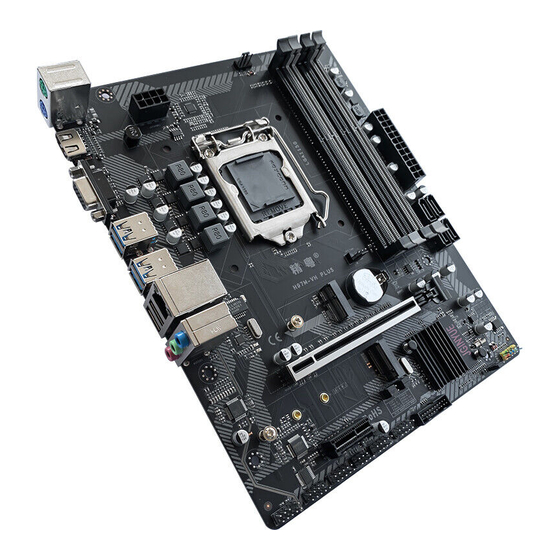
Table of Contents
Advertisement
Advertisement
Table of Contents

Summary of Contents for JGINYUE H97M-VHPLUS
- Page 1 H97M-VH PLUS User Manual http://www.jginyue.com/...
-
Page 2: Table Of Contents
Contents Specifications ......................1 Overview of Components ...................2 Install CPU & Fan ....................3 Install Memory ....................... 4 Install Expansion Card ....................5 Back Panel Connectors ...................5 USB 2.0 Port ..................... 5 VGA Port ......................5 USB 3.0 Port ..................... 6 RJ45 LAN Port ....................6 Audio Port ...................... -
Page 3: Specifications
Specifications H97M-VH PLUS Processor Intel Core i7/i5/i3 Celeron/Pentium/E3 LGA1150 pin series processor Southbridge H97 Chipset Technology Dual channel DDR3 Maximum 32GB (8G*4) Capacity Memory Slot 4 * DDR3 PS/2 1 * KB Interface; 1 * MS Interface Display Interface 1 * HDMI; 1 * VGA Rear I/O 2 * USB 2.0;4 * USB3.0 Ethernet... -
Page 4: Overview Of Components
Overview of Components Package List: H97M-VH PLUS Motherboard * 1 SATA cable * 1 I/O blocking * 1 — 2 —... -
Page 5: Install Cpu & Fan
Install CPU & Fan Please install the CPU into the CPU socket (LGA 1150) as shown below. Important • Make sure that the motherboard supports the CPU. • Always unplug the power cord from the power outlet before installing or removing the CPU to prevent hardware damage. -
Page 6: Install Memory
Install Memory The motherboard provides 4 DDR3 DIMM slots with a maximum capacity of 32GB. 1. Wrench the latches on both sides of the memory slot outwards. 2. Insert the memory into the slot by aligning it with the notch in the slot. 3. -
Page 7: Install Expansion Card
Install Expansion Card The motherboard provides a PCI Express 3.0 x16 expansion slot and a PCI Express 2.0 x1 expansion slot. Place the expansion card in an available PCI Express slot and press the expansion card until it is fully inserted into the slot. Important •... -
Page 8: Usb 3.0 Port
HDMI Port The HDMI port supports 4K and 1080px. You can use this port to connect your HDMI-supported monitor. USB 3.0 Port The USB 3.0 supports the USB 3.0 specification and is compatible to the USB 2.0 specification. Use this port for USB devices. RJ45 LAN Port The Gigabit Ethernet LAN port provides Internet connection at up to 1000Mbps/s data rate. -
Page 9: Internal Connectors
Internal Connectors F_PANEL1 Connector SPEAK1 Connector JAUDIO1 Connector This connector allows you to connect audio jacks on the front panel. Important • An incorrect connection between the module connector and the motherboard header will make the device unable to work or even damage it. —... -
Page 10: Jcom1: Serial Port Connector
JCOM1: Serial Port Connector The COM connector can provide one serial port via an optional COM port cable. SATA1~4: SATA 3.0 Connectors These connectors are SATA 6Gb/s interface ports. Each SATA connector supports a single SATA device. SATA M.2 Slot Insert your M.2 SSD into the M.2 slot at a 30-degree angle. -
Page 11: Wlan-1 Slot
WLAN-1 Slot The M.2 WiFi interface, which is compatible with WiFi AC standard expansion cards, can be used after the M.2 WiFi module is installed and the corresponding driver is loaded. JCMOS1: CMOS Discharge Important • Always turn off the computer and unplug the power cord from the power outlet before discharging. -
Page 12: Atxpwr1, Jatxpwr1: Power Connectors
ATXPWR1, JATXPWR1: Power Connectors With the use of the power connector, the power supply can provide enough stable power to all the components on the motherboard. Before connecting the power connector, make sure the power supply is turned off and all devices are properly installed. Important •... -
Page 13: Cpu_Fan1, Sys_Fan1: Fan Connectors
CPU_FAN1, SYS_FAN1: Fan Connectors CPU_FAN is a interface for CPU radiator. The 4pin fan has PWM intelligent speed regulation function, which can intelligently control the fan speed based on load and temperature changes. SYS_FAN is the system cooling fan interface, which is generally connected to the case fan. The 3pin fan has no PWM adjustment capability. -
Page 14: Bios Setup
BIOS Setup BIOS (Basic Input and Output System) records hardware parameters of the system in the CMOS on the motherboard. BIOS identifies, configures, tests and connects computer hardware to the OS immediately after a computer is turned on. Its major functions include conducting the Power-On Self-Test (POST) during system startup, saving system parameters and loading the operating system, etc. -
Page 15: Enter Bios Setup
∙ Go to BIOS and press F6 to load optimized defaults. ∙ Short the Clear CMOS jumper on the motherboard. Important • Be sure the computer is off before clearing CMOS data. Please refer to the Clear CMOS jumper section for resetting BIOS. http://www.jginyue.com/ — 13 —...



Need help?
Do you have a question about the H97M-VHPLUS and is the answer not in the manual?
Questions and answers